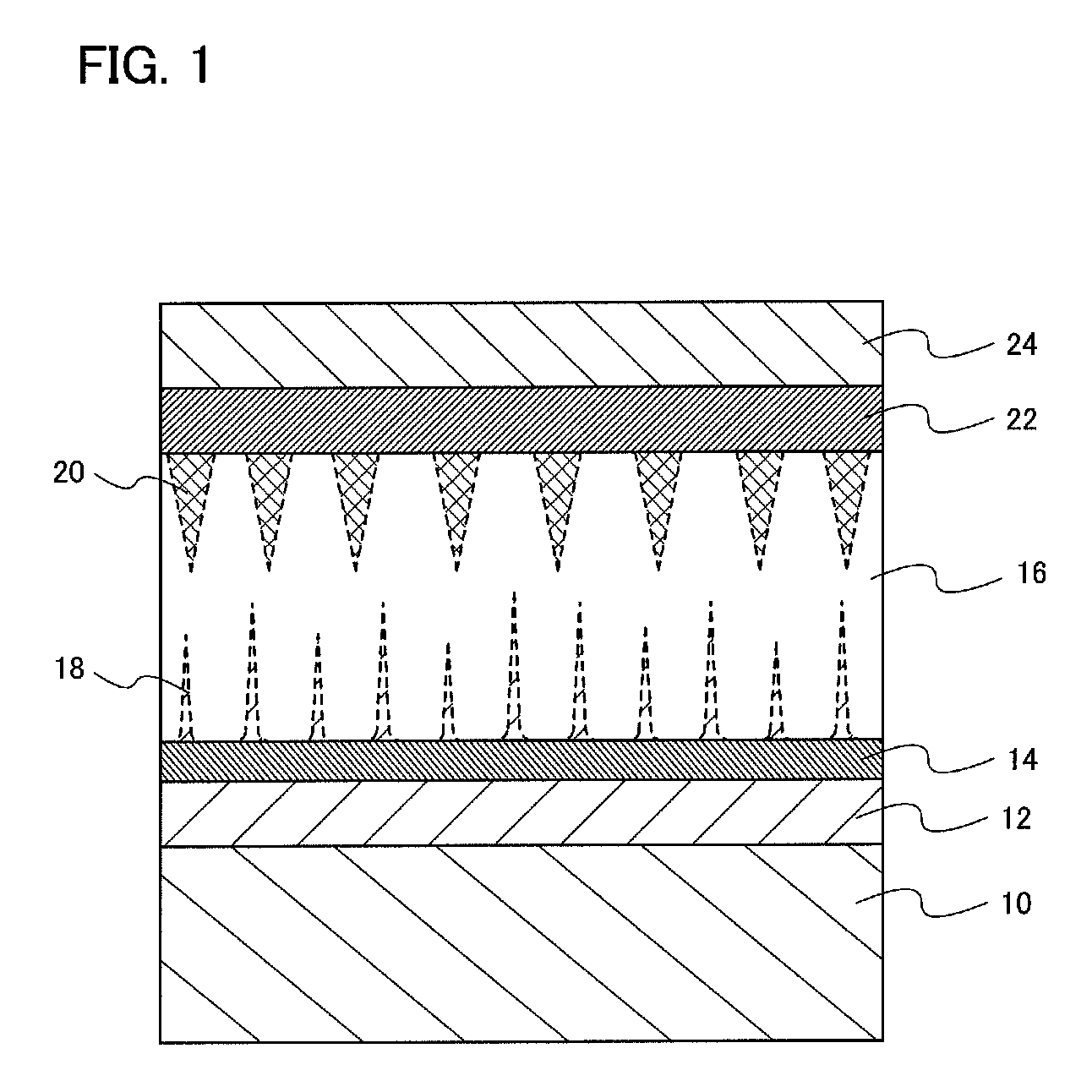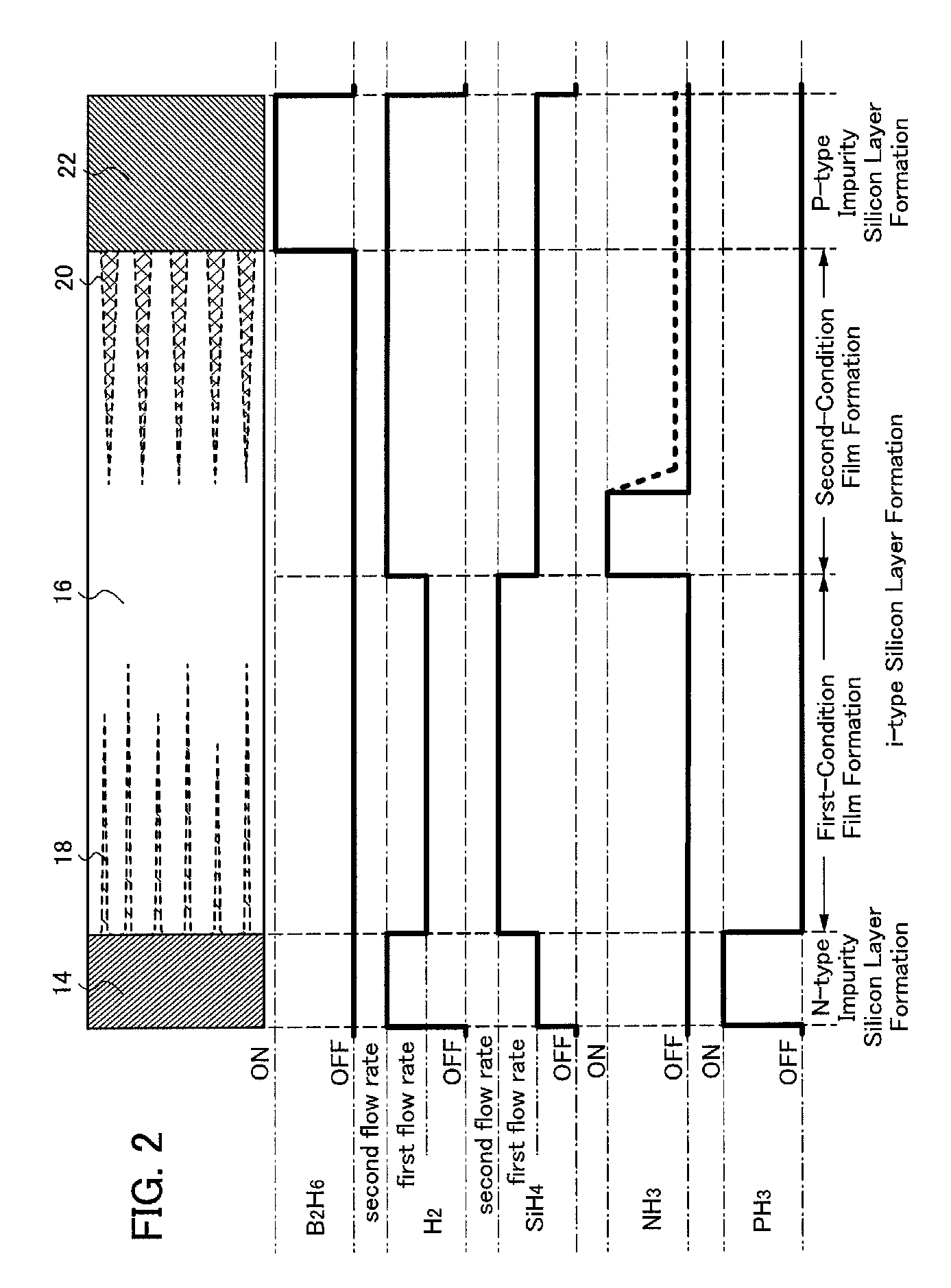Photoelectric conversion device and manufacturing method thereof
a technology manufacturing method, which is applied in the direction of semiconductor device, coating,plasma technique, etc., can solve the problems of low deposition rate, and low efficiency of photoelectric conversion device using microcrystalline silicon, so as to improve productivity, reduce the effect of change in characteristics and suppressing the effect of chang
- Summary
- Abstract
- Description
- Claims
- Application Information
AI Technical Summary
Benefits of technology
Problems solved by technology
Method used
Image
Examples
embodiment 1
[0040]FIG. 1 shows a structure of a photoelectric conversion device according to Embodiment 1. The photoelectric conversion device shown in FIG. 1 includes a first electrode 12 provided over a substrate 10, a first semiconductor layer 14 provided over the first electrode 12, a second semiconductor layer 16 provided over the first semiconductor layer 14, a third semiconductor layer 22 provided over the second semiconductor layer 16, and a second electrode 24 provided over the third semiconductor layer 22. The first semiconductor layer 14 and the third semiconductor layer 22 are impurity semiconductor layers in which the conductivity types of impurity elements added thereto are opposite to each other; one is an n-type semiconductor layer and the other is a p-type semiconductor layer. The second semiconductor layer 16 provided between the first semiconductor layer 14 and the third semiconductor layer 22 is an i-type semiconductor layer in which a first crystal region and a second cryst...
embodiment 2
[0084]FIG. 5 illustrates the structure of a photoelectric conversion device according to Embodiment 2. The photoelectric conversion device includes at least one semiconductor junction by a second semiconductor layer 16 of an i-type semiconductor which is interposed between a first semiconductor layer 14 of an n-type semiconductor and a third semiconductor layer 22 of a p-type semiconductor. Shown here is the structure in which a low-concentration impurity semiconductor layer 13 is provided between the first semiconductor layer 14 and the second semiconductor layer 16. The low-concentration impurity semiconductor layer 13 is a semiconductor layer in which an impurity element imparting the same conductivity type as the first semiconductor layer 14 is contained and the impurity concentration is lower than that in the first semiconductor layer 14. Described in Embodiment 2 will be the example in which the low-concentration impurity semiconductor layer 13 is an n-type semiconductor.
[0085...
embodiment 3
[0093]In Embodiment 3, a so-called stack (including tandem) photoelectric conversion device in which a plurality of unit cells is stacked will be described. Described in Embodiment 3 will be the example of a photoelectric conversion device in which a unit cell including a single crystal semiconductor layer (typically single crystal silicon) and a unit cell including an amorphous semiconductor layer (typically non-single-crystal silicon) are included as a bottom cell and a top cell, respectively.
[0094]A photoelectric conversion device shown in FIG. 6 includes a first electrode 12 provided over a substrate 10 with an insulating layer 51 interposed therebetween, a unit cell 40 including a single crystal semiconductor layer, provided over the first electrode 12, a unit cell 30 including a non-single-crystal semiconductor layer, provided over the unit cell 40, and a second electrode 24 provided over the unit cell 30.
[0095]The unit cell 30 has a stack-layer structure of the first semicond...
PUM
 Login to View More
Login to View More Abstract
Description
Claims
Application Information
 Login to View More
Login to View More - R&D
- Intellectual Property
- Life Sciences
- Materials
- Tech Scout
- Unparalleled Data Quality
- Higher Quality Content
- 60% Fewer Hallucinations
Browse by: Latest US Patents, China's latest patents, Technical Efficacy Thesaurus, Application Domain, Technology Topic, Popular Technical Reports.
© 2025 PatSnap. All rights reserved.Legal|Privacy policy|Modern Slavery Act Transparency Statement|Sitemap|About US| Contact US: help@patsnap.com



